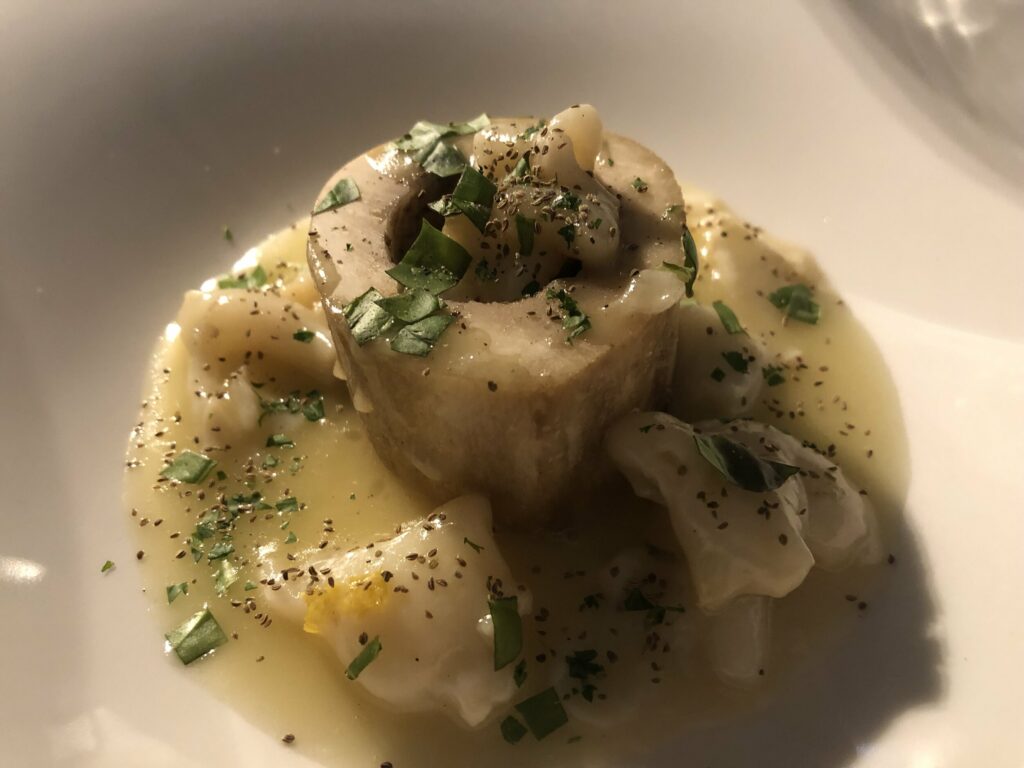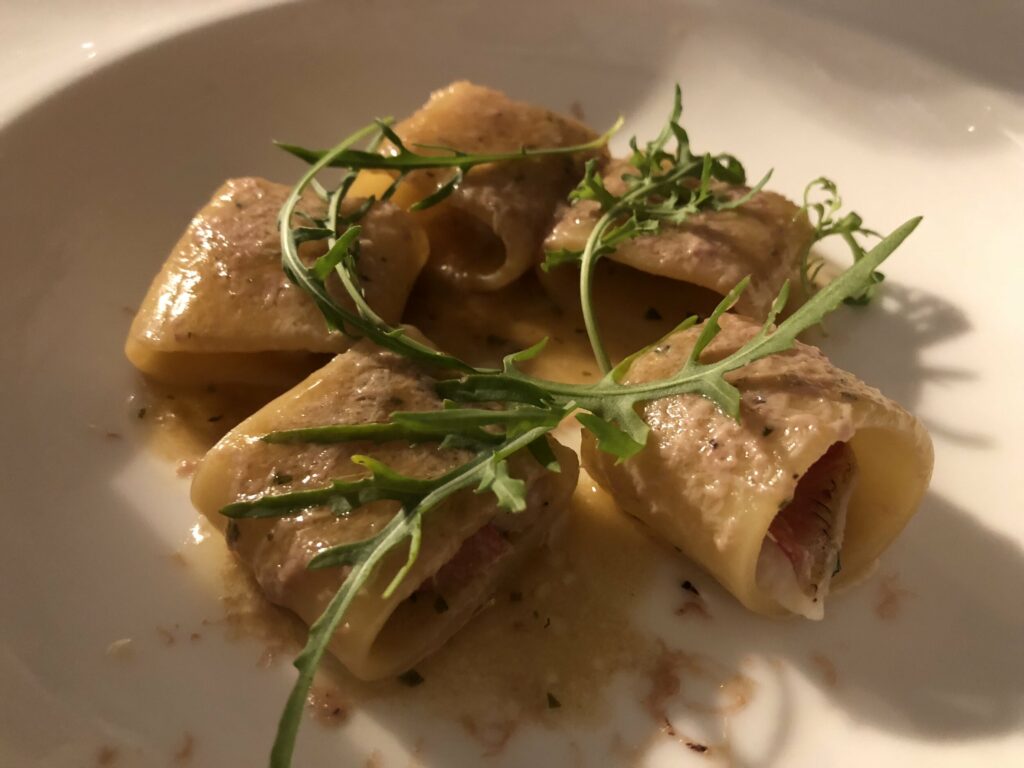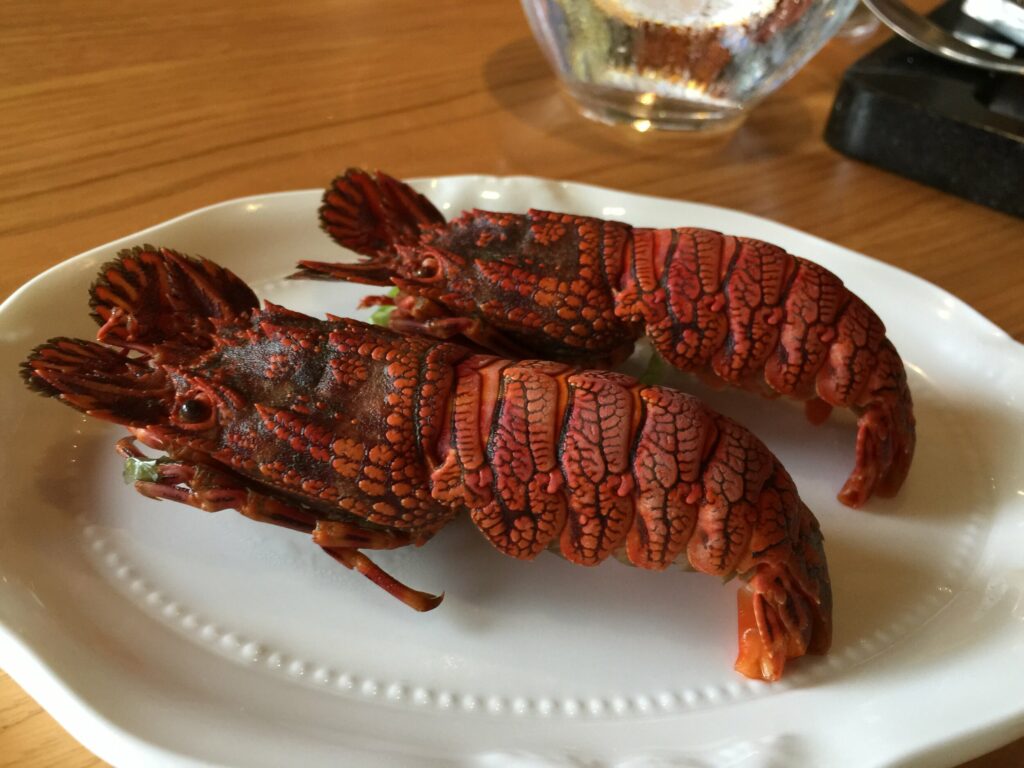How can one justify talking about these two seemingly very different restaurants in the same article? Uliassi is a Michelin three-star seafood restaurant on the Adriatic coast of Italy and Casa Marcial hails from the countryside of Asturias in Northern Spain. It is very likely that chef Mauro of Uliassi and Nacho Manzano of Casa Marcial have never dined in each other’s restaurant, and they may have never met. So imitation is out of question, and inspiration is highly unlikely.
But they are united in a deeper sense. That is, while both Mauro and Nacho are technically highly skilled chefs who operate within the parameters of contemporary fine dining, they both strive for an “authenticity” which is not reducible to a return to classic, traditional cuisine with extra refinement. This may be a reason why Mauro only recently achieved the well-deserved three stars and Nacho never did. They do not feature very high in global lists either.
This relative lack of recognition, or late recognition is, firstly, due to the fact that these chefs do not tailor their cuisine to the dictates of globalized trends in the high end of dining and to the standardized expectations of judges. Accordingly, they put a premium on products over technique, and on taste over pure aesthetics. As much as these two chefs are inspired by tradition and local products for their vision of cuisine, they do not look backwards, but instead look forward and charter towards unknown territory. This search propels them towards risk taking and experimentation and, at times, there may be a few less than perfect dishes. However, even the relatively less successful dishes are not concocted to awe and dazzle. They are concocted to redefine tradition by pushing its boundaries to explore the UNTAPPED POTENTIAL of traditional dishes and regional ingredients. I call this an attempt to search for “authenticity”. In our age when hyper trendy restaurants are essentially reinforcing their dishes with extra-culinary elements, that is by embellishing them with a narrative rooted in the chef’s childhood (1), Mauro and Nacho let the dishes tell their own stories (2). This indicates a respect for the customer’s palate and intelligence. I should add that when one tastes a top dish at Uliassi or Casa Marcial, its memory lingers for a long time. This is the opposite of the cuisine of chefs who cook to meet the expectations of (often non-paying) the World’s 50 Best Restaurants list’s judges who look for “originality”, rather than “authenticity”.
Let’s consider some examples. Take the “brodetto” of Maura and the “fabada Asturiana” of Nachado. These two are possibly the most typical dishes of their respective regions. It takes real courage for high end restaurants to offer them, especially if these high end restaurants aspire to receive accolades from the arbiters of taste and the Guide Michelin (3). Actually one has to ask for these dishes when reserving. But, one is rewarded if one does ask for these traditional dishes.
The brodetto is actually a masterpiece and a “reference point” in the category of fish soup or consommé. It is noteworthy in its balance of the multi-dimensional aroma and layered flavors. Its texture is rich, but not heavy. I believe Mauro prepares the brodetto from sea water. The fish and shellfish in the brodetto are supporting actors, and I recommend to consume them after drinking the consommé.
The fabada Asturiana, on the other hand, is as good as the version at Casa Gerardo. It is a rustic dish where each bite of the giant beans reveals the considerable depth of pork jus. We also taste the outstanding processed pork products from the region (morcilla, chorizo, tocino).


Obviously these two dishes are not examples of “chartering towards unknown territory,” but rather homages to tradition without cutting corners. In my opinion, because Mauro and Nacho have mastered the tradition so well, they have the right to tinker with it. They tinker with tradition to extract the maximum flavor from ingredients by using a combination of traditional (maceration, pickling) and modern (de-hydration) techniques. The most memorable of these dishes contain strong tastes, but the richness does not come at the expense of harmony. Interestingly, both chefs make ample use of the offals/internal organs of fish and meat in these truly authentic dishes. This is a far cry from the world of trendy celebrity chefs whose aesthetic concerns in plating take precedence over balanced and rich flavors. Indeed, the textural contrast in most of Mauro’s and Nacho’s dishes stem from the inclusion of gelatinous internal organs/offals rather than recourse to fashionable techniques, such as liquid nitrogen and morphing. These dishes are designed less for Instagram photos than for the satisfaction of carnal desires. They contain only a few elements, together with strong and assertive flavors rarely found in contemporary avant-garde temples of cuisine.
Over the last four years I have visited each of these two restaurants five times. Uliassi offers two menus: classics and the so-called “lab” of the year. They consist of eight portions and two desserts. They also have a la carte options. Casa Marcial, on the other hand, offers only a single menu of ten portions and two desserts.
Consistency is the hallmark of both restaurants. When I look back and read my notes, I have not noticed any quality differences among the meals. I have also starred (meaning a minimum of 18/20) about a third to half of the dishes in every meal. The rest of the dishes merited 15 to 17/20.
Amuses do not change much at Uliassi, and we always enjoy the regional nuances, such as a green olive stuffed with raw meat and crunchy olives. But the feast begins with the arrival of shellfish in various forms. In our last visit on June 16, 2019, we asked for the “lab” menu, but substituted some dishes from the a la carte menu. One outstanding dish was “raw oyster with ciauscolo fat”. Ciauscolo is a variety of salume from Marche. It appears like a veloute of oyster, reminiscent of Bernard Pacaud’s veloute of scallops, with an equally silky texture. The sweet ciauscolo fat compliments beautifully the slightly saline-metallic taste of the oyster liquid without altering the chewy texture. Together with a local Verdicchio wine, with its sea spray nose and lean body, this oyster dish achieves a regal status.


Equally regal was the “bread, almonds and granita of sea urchin.” This dish was also based on a similar logic to the oyster (they are from two different menus), combining very few ingredients, but reversing the roles. That is, here, the sweetness of the sea was set against the almond cream with its bitter nuances. Small croutons added crispness to the combination and contrasted with the almond cream. While Mauro transformed the texture of the sea urchin, the “granite” enhanced the intensity and ocean essence flavors of the sea urchin and added a temperature contrast. The verdicchio worked equally well with the sea urchin dish.
“Smoked eel grilled over charcoal” was also successful. The gelatinous and intense flavor of the eel was offset by equally assertive and bitter-acidic burnt bergamot and orange extract. Bitter and crunchy leaves, such as dandelion, celery, radicchio di Treviso, added freshness and lifted the aromatic profile of the dish. After my last bite I was able to savor the interplay of lingering strong flavors for a few minutes, until the next course arrived. This dish went extremely well with the glycerin-rich Mosse Chenin that I ordered. 2012 Mosse Initiale BB is at its peak and is characterized by the purity of dense fruit reminiscent of agrumes, quince, and kumquat. It has a touch oxidative nose, which adds complexity to this impressive Chenin.


“Seafaring marrow bone” was one of the best “terre et mer” combinations that I have tasted to date, on par with the “espardenyes and porc feet” served by Juan Roca before he received his third Michelin star. The bacalao tripe and bone marrow were tied together by a natural “pil pil” sauce. Thinly sliced celery leaves cut the gelatinous richness of the dish and added freshness. The complex flavor and textural density of this dish was akin to another amazing gelatin-rich dish that Mauro has not prepared this year. It was called “il mare dentro”. Composed of cod tripe, monkfish and triglie (red mullet) livers and poached turbot heart, “il mare dentro” was an exploration of the untapped potentials of the so called “noble fishes,” such as rombo and triglie. Internal organs of the fish are subtler in taste than offals of red meat, but they are often discarded in fine dining establishments. Yet they are more nuanced in taste, and more interesting texturally, than the white flesh of the fish. In “il mare dentro” Mauro took what is essentially a traditional Marche fisherman stew and elevated it to a higher status by calibrating the flavors. To calibrate the flavors he cooks different components of the dish separately (which is not the case in a traditional stew), before bringing them together with an acidic-herbaceous sauce containing sorrel. The dish is a “quintessence of rustic elegance.” I am afraid that he may give up from it as “il mare dentro” may be too challenging for the majority of international clientele.


Another reason I think very highly of Uliassi is his pasta dishes. There are usually two pasta dishes on each menu, and some more are offered as a la carte. The majority are seafood pastas, but one should not miss the ravioli of game meat with pigeon jus, if it is on the menu. Mauro always impressed me as a “saucier” and he remains loyal to the basic classical French techniques for the sauces. For instance, in 2018, he prepared a “mezze maniche” with triglie, triglie liver, and beurre blanc. It was remarkable. This year he proposed a “fusilloni with octopus’ lard and rosemary”. Lardo was not from pork, but from the thin layer of fat under the skin of the octopus. He prepared it just like a classical lardo, with coarse salt and rosemary. He sprinkled some bottarga on top. The pasta was not just original, but also memorable. A no non-sense take on tradition.


I usually end my meal with the brodetto at Uliassi. Otherwise I am less tempted by fish than game. All the game preparations I tried were successful. This year Mauro offered a surprising dish: “lamb head.” This dish is another proof of the fact that, unlike ultra-modern chefs, Mauro does not like to manipulate the texture of ingredients, but loves to combine multiple textures. The tongue, brain, cheek, and eye of the lamb cover a whole gamut of textural and taste differences. They were brought together by an acidulated green herbal sauce and croutons dipped in meat jus and topped with shaved pecorino. This dish was not better than a classical “tete de veau ravigote” prepared by a bistro that does it justice. Nevertheless, this is indeed high praise as most meat dishes in Michelin three stars/the World’s 50 Best Restaurants are not as satisfactory as good bistro dishes.

Desserts are good at Uliassi, such as the Padua cherry-vanilla gelato (excellent quality) and walnut crumbles combination. Yet, if I order a la carte, I bypass them to enjoy the petit fours with espresso. Do not miss the white chocolate and gorgonzola concoction.

An overriding interest in exploring an array of textural and aromatic differences of natural ingredients, without adding artificial aroma or a chemical element to alter texture, also characterizes Manzano’s cuisine in Casa Marcial. He also explores “terre et mer” combinations and aims to create earthy, rich dishes. Given his aim, like Mauro of Uliassi, he is fond of offals, giblets and internal organs of fish.
To give an example, “Bone marrow, cod tripe, parsley emulsion and anchovy” is quite a daring concoction. It combines not one, but two elements, which are the very definition of rich gelatinous texture. He then adds an earthy component that is wild mushrooms (not in the description of this dish), and a preserved Cantabrian anchovy which is very savory or umami-like. It is really not easy to pull all of these ingredients together with such strong flavors and extreme textures. Yet the dish does not taste unbalanced. The flavors are by no means subtle, and all ingredients assert themselves with equal force, bound together by a refreshing parsley coulis.

The dish which precedes the bone marrow is equally strange. The way it is written in the menu is not too appetizing: “Colagen(sic), pickled turnip and watercress”. The collagen turns out to be a beef consommé. How should I describe the taste? Brandon Granier, in his review of Kawamura in Gastromondiale, says that Kawamura’s beef consommé is “…a studied balance in flavor, aroma and texture….until you taste this consommé you cannot understand what beef savoriness can achieve…”. The savory element in Nacho’s version of “collagen” consommé at Casa Marcial may also be partially coming from the smoked eel and pork ear whose flavors are integrated in the consommé. These smoky elements also guard against extracting too extreme flavors (saltiness or sweetness) from beef bones. The lightly pickled turnips are cut like ribbons, and they sit in the middle of the consommé and are topped by wild watercress leaves. The inclusion of both the aromatic watercress and pickled turnips help to lighten and refresh the dish without changing the focus.

Given these two examples from my 5th meal at the Casa Marcial which was in November 2018, I may have given the impression that his tasting menu is a bit arbitrary and overly rich. This is not true. It is a well thought out menu which starts out relatively simple, before journeying into riskier territory (as in the examples above), before settling into a more comfortable and traditional zone. But throughout the journey one notices a desire to impart a “depth” to rustic dishes in terms of both flavor and texture, which mostly works. When such dishes are less successful, it may be because Manzano is searching too much for “elusive” umami flavors or because he unnecessarily plays with texture of a perfect ingredient.
The part of the meal I am most concerned about at Manzano’s restaurant is the very beginning: amuses. Some of the amuses make me think that the excellent chef may be unnecessarily trying to prove that he knowns all the modern fads and techniques. He usually offers four to six amuses and his forays into Japanese territory are not convincing. For example, the “clam and frozen water, seaweed puree” is too salty and lacks balance. Another amuse “crispy seaweed with lemon reduction,” is a non-sense dish, displaying technical wizardry, but nothing else.

Yet some amuses contain no gimmicks and display some of the rarest and most flavorful sea products, such as baby cigale de mer (“santiaguino”) and limpets (“lampares”). Some others come across as renditions of comfort food par excellence, such as “corn soufflé with smoked sardine and onions”, and “jamon croquette”.


At the beginning of this section I highlighted two of the best dishes which encapsulate Manzano’s rustic elegance at its best. Yet the rest of the menu is also very satisfactory, despite occasional less than perfect dishes, and the consecutive ordering of the dishes makes sense. The first course in our November 2018 meal was a sashimi of red mullet (“salmonetes”) with its own crispy skin. This was a nice beginning. This was followed with “sea urchin with aniseed contrast”. The local sea urchin (“oricio de mar”) was outstanding, lean and mineral, the quintessence of the ocean sweetness. Thinly cut apple, celery, and fennel seeds, added textural contrasts and a touch of citrus and spice. Yet some drops of yogurt and also the hollandaise sauce were too much. The hollandaise sauce was meant to be a binding element (as in French royale d’oursin), but it detracted from the glorious sea urchin flavor.

The next two dishes, however, were conceived without culinary extravagance. “Asturias beef from the mountain with milk and herbs” featured excellent quality casina race cows (from Leon), thickly cut carpaccio with aromatic herbs, edible flowers, milk and trout roe. The rich, creamy, acidic unpasteurized milk cream reminded me of very fresh stracciatella of Puglia. The “Vegetable Garden” was equally impressive, not only in presentation, but also in terms of the balance and depth of flavors. The bean puree held together seasonal herbs and vegetables, some raw, others steamed, and pickled onions.


The next two above-mentioned dishes, that is “Colagen, pickled turnips and watercress” and “Bone marrow, cod tripe, parsley emulsion and anchovy” were the highlights of the meal. Yet we had five more dishes before the desserts. Grilled spiny lobster (“langosta”) from Asturias was a textbook example of the “a la brasa” technique, as good as Etxebarri’s. Pan cooked wild seabass with seaweed and mushrooms, featured an excellent beurre blanc infused by earthy porcini and black trumpet mushroom flavors. The mushrooms were firm and made me think that they were picked the same morning. I thought the algae to be an unnecessary accessory, but it did not detract from the taste. Wild duck with limpets was equally good in terms of the ingredient quality although I did not see how the limpets contributed to the dish. The idea of “land and the sea” seemed forced in the dish and the duck jus thickened by squid ink was not convincing. Yet the carnaroli risotto with raw porcini and egg yolk was quite sensational. Equally explosive on the palette was the final course: caramelized wild boar in a rich broth of shell beans, smoked paprika and bone marrow.



I have some words on wine. Wine is a strong suit of Casa Marcial. They have some very good French wines, such as Clape Cornas which marry well with the latter part of the meal. I also have found some excellent and rare wines from Galicia. But I prefer to pair as many dishes as possible with sherry, as the sommelier is an expert, and there is always a variety of sherries which complement the dishes here. The one pictured below turned out to be an excellent pairing with the earthy risotto.
Desserts are not an afterthought here. Manzano usually offers a classic, such as the great “arroz con leche,” followed by a modern creation. Last November the modern creation was “milk and grass,” condensed sweet non-pasteurized milk and an herbal infusion. It tasted as good as it looks.

Uliassi: 18/20
Casa Marcial: 18/20
(1) To quote from ‘The Society of the Illusionists: The World’s 50 Best Restaurants List’ by Hatinoglu et al; published earlier in Gastromondiale in the context of Osteria Francescana, the W50’s number one restaurant in 2016: “… they bring an oyster shell on a bed of salt…This is Bottura’s attempt to capture a memory of his childhood holiday in Normandy. He drank cider, and ate oysters and lamb. The dish is adequate…but-all this problem with philosophical food-it cannot bear the burden of expectation set upon it; no food could. These are Bottura’s memories, not mine, and so-I am sure this is not his intention-the eating of them feels like something of an imposition.”
(2) So much of high end dining today entails a show on the part of the server who tells the story of the dish. At times this amounts to patronizing the diner, akin to brainwashing.
(3) I have actually learned this from the ex-director of the Michelin guide. He told me that they do not give three stars for the most common traditional dishes even if a restaurant prepares the ultimate version. The example he gave was “tagliatelle Bolognese”. I suppose the same holds true for brodetto or fabada. Clearly Mauro has not received the third star for brodetto, which is no longer on the menu. One should ask specifically for brodetto.






it’s interesing how in asia though they do give a lot of stars that restaurants composed of mostly traditional dishes